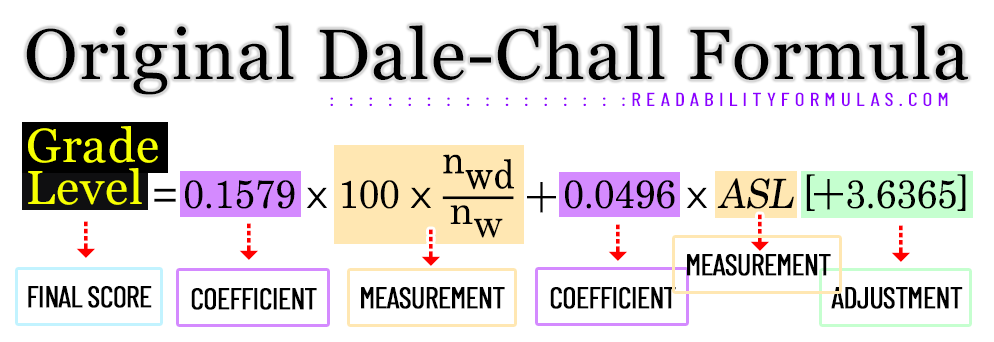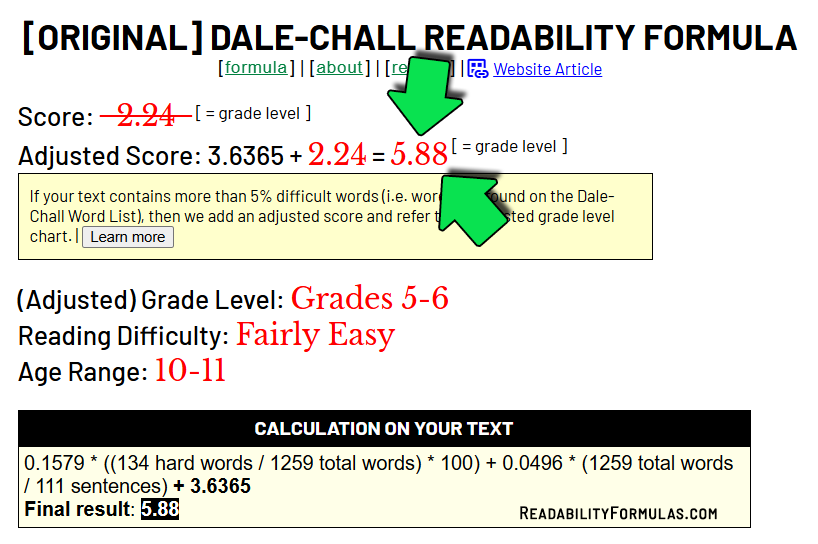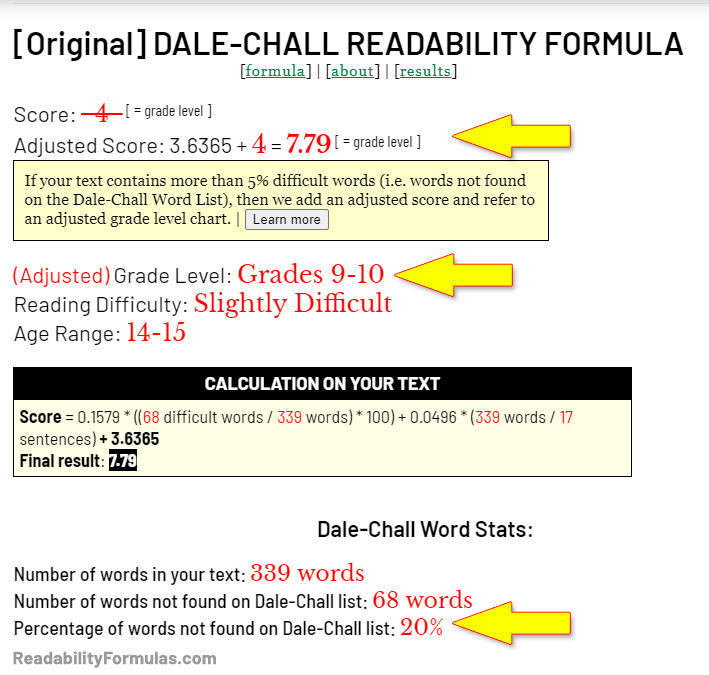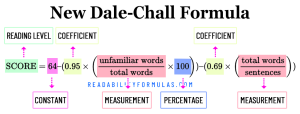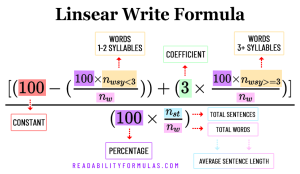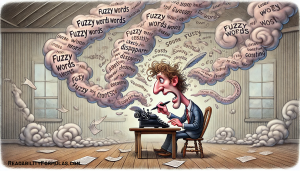The (Original) Dale-Chall Readability Formula was developed by Edgar Dale and Jeanne S. Chall in 1948 as a tool to estimate text difficulty and assess which age groups or grade levels could read the text. The formula uses two measurements: the percentage of difficult words (# of difficult words / # of words) and the average sentence length (ASL). The formula is as follows:
$$0.1579 \times 100 \times \frac{n_{wd}}{n_{w}} + 0.0496 \times ASL [+ 3.6365]$$
The Original Dale-Chall Readability Formula
nwd = number of difficult words
nw = number of words
nwd / nw x 100 = yields the percentage of difficult words
ASL = Average sentence length (total words / sentences)
The final score is the grade level (refer to the table below). The following score ranges are based on extensive testing with various grade-level students.
For example, a text with a score between 4.9 and 5.9 is appropriate for readers with a 5th grade or higher education.
Score: 0 - 4.9Grade Level: Kindergarten - 4th gradeReading Level: Beginner/Early elementary |
Score: 9.0 - 9.9Grade Level: 9th gradeReading Level: High school |
Score: 5.0 - 5.9Grade Level: 5th gradeReading Level: Elementary |
Score: 10.0 - 10.9Grade Level: 10th gradeReading Level: High school |
Score: 6.0 - 6.9Grade Level: 6th gradeReading Level: Elementary |
Score: 11.0 - 11.9Grade Level: 11th gradeReading Level: High school |
Score: 7.0 - 7.9Grade Level: 7th gradeReading Level: Junior high/middle school |
Score: 12.0 - 12.9Grade Level: 12th gradeReading Level: High school |
Score: 8.0 - 8.9Grade Level: 8th gradeReading Level: Junior high/middle school |
Score: 13.0 and aboveGrade Level: College level and beyondReading Level: College/Advanced |
How the Dale-Chall Formula Calculates Readability
The Dale-Chall formula uses coefficients and adjustments to measure the readability of a text. These numbers quantify the cognitive effort needed to understand its words and sentences. Each number balances the contributions of word familiarity and sentence structure.
Word Familiarity:
Analyzing text difficulty relies on word familiarity. The original formula used 763 familiar words known to fourth-grade students. The new formula uses 3,000 words that young and adult readers find familiar. Any word not on this list is flagged as unfamiliar. By counting the percentage of unfamiliar words in a text, the formula scores word difficulty in a nuanced way.
Sentence Length:
The formula factors in average sentence length. It assumes longer sentences increase text complexity. Sentence length is measured by the average number of words per sentence.
0.1579 (Multiplier for Word Difficulty)
Purpose: This coefficient weighs the impact of difficult words (those not found on the Dale-Chall list of 3,000 familiar words) in determining readability.
Role in the Formula: Difficult words increase reading difficulty. This coefficient ensures difficult words impact the readability score. It amplifies vocabulary simplicity over sentence length, as unfamiliar words need more cognitive effort to process than familiar ones.
Reason for Value: The 0.1579 coefficient predicts reading difficulty more reliably when combined with sentence length data.
0.0496 (Multiplier for Sentence Length)
Purpose: This coefficient adjusts the influence of sentence length (words per sentence) on readability.
Role in the Formula: Longer sentences increase complexity by requiring readers to process and retain more information before reaching a full thought or conclusion. However, this impact is less significant than unfamiliar vocabulary. 0.0496 is much smaller than 0.1579, reflecting that sentence length contributes to readability but is secondary to word familiarity.
Reason for Value: This coefficient accurately represents the real-world impact of sentence length when paired with word familiarity.
3.6365 (Grade Adjustment)
Purpose: To align readability scores with U.S. grade-levels, Dale and Chall introduced an adjustment number through empirical research. It estimates grade levels more accurately, especially beyond 4th grade. If your text has more than 5% difficult words, the formula adds 3.6365 to the score.
Role in the Formula: This adjustment ensures the formula accounts for the increased difficulty readers experience when reading texts with many unfamiliar or complex words.
Reason for Value: Texts with more than 5% difficult words become disproportionately harder to read, not just slightly harder.
The adjusted score matches an adjusted grade level . Refer to this chart when your text exceeds 5% difficult words:
| ADJUSTED GRADE LEVEL CHART |
| ADJUSTED SCORE | NEW GRADE LEVEL |
| 4.9 and Below | Grade 4 and Below |
| 5.0 to 5.9 | Grades 5 – 6 |
| 6.0 to 6.9 | Grades 7 – 8 |
| 7.0 to 7.9 | Grades 9 – 10 |
| 8.0 to 8.9 | Grades 11 – 12 |
| 9.0 to 9.9 | Grades 13 – 15 (College) |
| 10 and Above | Grades 16+ (College Grad) |
Below is a screenshot showing how the adjusted number re-scores the grade level because the text contains 20% of difficult words.
The original and updated versions of the Dale-Chall Formula are popular because of their accuracy, simplicity and purpose. They help educators and writers match texts to readers’ comprehension levels, and they both help edit and revise text to target their intended audience.
Don’t know which version to use? The original or the updated one? ReadabilityFormulas.com lets you score your text using both versions of Dale-Chall, using the same expanded word list of 3,000 words.
Score your text now, or learn about the updated version of Dale-Chall.
Scott, Brian. “The Original Dale-Chall Readability Formula.” ReadabilityFormulas.com, 4 Jan. 2025, https://readabilityformulas.com/the-original-dale-chall-readability-formula/.
